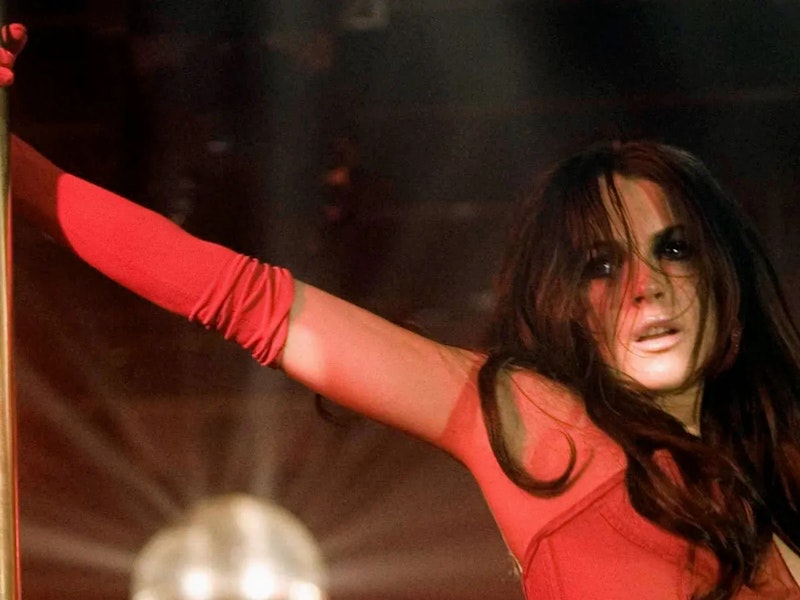Three days before I Know Who Killed Me was released in theaters, Lindsay Lohan was arrested on suspicion of drunk driving and cocaine possession, her second DUI/coke twofer in as many months. In between arrests, photos leaked online of a heavily intoxicated Lohan and friends posing suggestively with a butcher knife. In the parlance of a bygone era, she was a girl gone wild. Our scandalized nation could only watch in horror as the once angelic kid morphed into a freckly tornado of pills and hair extensions. What happened to our Lindsay?
Child stardom, for one. Lohan rose to fame after starring in a remake of The Parent Trap when she was only 11. By many accounts, her mother Dina was a classic showbiz momager who prioritized Lindsay’s career over her education and well-being. She starred in two hit comedies in quick succession: 2003’s Freaky Friday (no idea why Lohan was so in-demand for Disney live-action IP, a pattern that continued with 2005’s Herbie Fully Loaded) and 2004’s Mean Girls. By the time she was 18, she was already a multi-millionaire It Girl whom everyone wanted to work with. Like many a child actor before her, she was ready for the big leagues.
At first glance, it’s tempting to dismiss I Know Who Killed Me a big league swing-and-a-miss, a child star’s transparent attempt to trade their precocious image for that of an “adult” actor and serious thespian. Judging on that criterion alone, the movie’s a failure. If Lohan wanted to be taken seriously as an actress, it’s hard to imagine a worse career move than taking on the dual roles of Aubrey Fleming and Dakota Moss. Just typing the names out is making me laugh. But on a metatextual level—specifically, as a film about the child star’s painful transformation into sex symbol—I Know Who Killed Me is surprisingly self-aware and, at times, even intelligent.
The metatextual reading makes sense partly because no other reading does. Even by the generous metrics of this column, I Know Who Killed Me is a ridiculous movie, like if Lost Highway were rebooted as a CW series. Lohan stars as Aubrey, piano prodigy and amateur writer, who’s kidnapped and tortured after a high school football game. Meanwhile, a stripper/Aubrey doppelganger named Dakota shows up on the side of the road missing limbs. It’s clear the two characters/events are connected, but it takes a movie’s worth of investigating to arrive at the insane conclusion: Aubrey and Dakota are twins separated at birth, and Dakota’s missing body parts is part of a phenomenon known as Stigmatic Twin Syndrome. When Aubrey’s kidnapper removes her limbs, Dakota forms identical wounds.
When Dakota’s body parts start falling off, she’s taken in by Aubrey’s parents (Julia Ormond and Neil McDonough). Despite her protests to the contrary, they call her Aubrey and choose to ignore the obvious differences between their nice, honors student daughter and the comparatively crass Dakota, including the latter’s chain-smoking and not-so-secret sexual appetites. In one standout scene, Aubrey’s mom furiously scrubs dishes in her kitchen, trying to ignore Dakota loudly fucking Aubrey’s boyfriend upstairs.
It doesn’t take a genius to notice that this is a callback to Lohan’s first film role, where she also played identical twins separated at birth. By evoking Lohan’s emergence as a child star, the film draws thematic links between Aubrey/Dakota—the honors student and the stripper, the innocent and the corrupted, the virgin and the whore—and Lohan’s own fractured public image. Following that logic, I Know Who Killed Me depicts the child star’s innocence violently ripped from her, rendering her a drunken, disfigured, ashtray-voiced mess. It’s an unusually sturdy metaphor for a movie this stupid: the young, innocent Lindsay pays for the sins of the industry-hardened, sexualized Lindsay, who suffers in sympathy with her former self.
Aubrey’s kidnapper turns out to be her piano teacher, taking revenge against her for the betrayal of discontinuing their lessons. The villain being an overbearing authority figure trying to live vicariously through the teenage Aubrey may be a not-so-subtle dig at Dina Lohan, but to conclude that Dina’s the villain of Lindsay’s story would be wrong. Dina is just a symptom of a larger system of objectification, sexualization, and exploitation in the entertainment industry, a system that grooms young girls to be sex objects only to punish them for it later. Lindsay’s string of arrests around the time of the film’s release was clearly a cry for help from a troubled young woman who was still barely old enough to buy alcohol. How did the press react? They ridiculed her with unflattering photos and gave her a Razzie for Worst Actress.
What happened to our Lindsay? The answer might have something to do with thinking she was ours in the first place, and her exile from Hollywood—save for a couple cheapie “comeback” movies for Netflix—may just as well have been in her best interest. I Know Who Killed Me ends with Dakota saving Aubrey, and the reunion between the jaded sexpot and her more innocent half foreshadowed Lohan’s own eventual rehabilitation. She now lives with her financier husband and newborn baby in Dubai, about as far from Hollywood as humanly possible. When I look at recent photos from Lohan’s Instagram, she seems content, healthy, unburdened by the shackles of stardom—like she’s living her best life. In an industry that too often chews up wide-eyed young girls and spits out broken women, that’s about as happy an ending as one could hope for.

